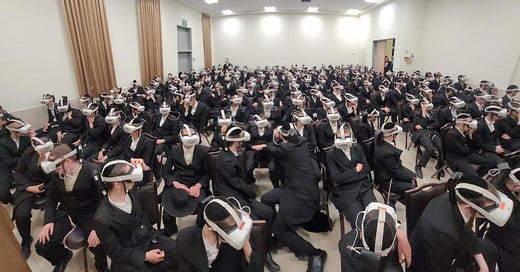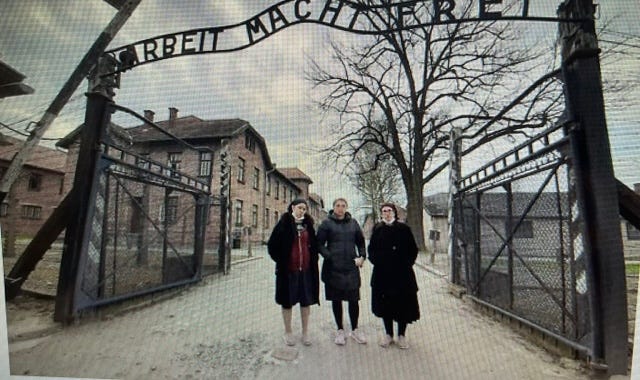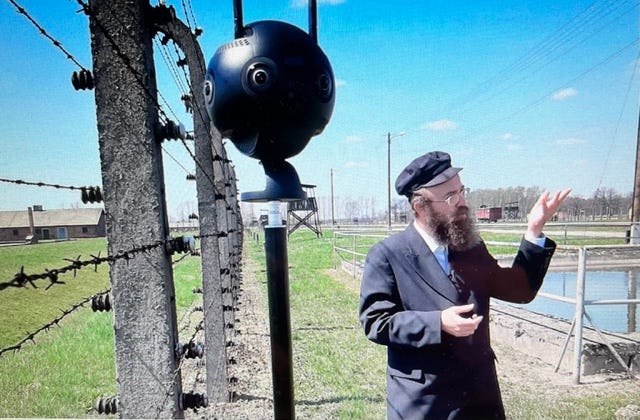A Tour Of Auschwitz Like No Other
How the first 360-degree full-length VR (Virtual Reality) Holocaust film, soon to be shown in the U.S., was made by three charedi Israeli women.
A visit to another world: students at a Jerusalem yeshiva experiencing the VR filmed tour of Auschwitz.
When Miriam Cohen was a teenager growing up in Modi’in Illit, Israel, she was upset to learn that her charedi school would not be participating in an educational tour to Poland, a rite for many thousands of Israeli high school students.
“I complained to teachers and school administrators because I felt a connection to the Holocaust story and wanted to learn more about it,” Cohen told me during a recent Zoom interview. “I felt like I was missing out on an important experience.”
She came to understand that while the charedi community has deep ties to the Holocaust, there was a cultural barrier to allowing young people her age to travel outside of Israel without family.
But Cohen promised herself that one day she would visit Holocaust sites in Poland.
Not only did she keep that promise, but she did so in an extraordinary way, playing a key role in providing a unique, powerful tour of the Auschwitz-Birkenau concentration camp not only for charedim but for all types of Jews as well as non-Jews in Israel and, potentially, around the world.
The tour is a virtual one, the first 360-degree full-length VR (Virtual Reality) film on the Holocaust, and was produced by Cohen and her two charedi fellow producers, Chani Koplowitz and Yuti Neiman. The experience, which calls for viewers to wear specialized 3D glasses and headsets, is revelatory and in some ways more real and emotional than touring the camp in person for many, including me.
The title of the film, “Triumph of the Spirit 360,” refers to the countless European Jews who clung to their faith and its rituals in the midst of the hellish horrors of Auschwitz, giving up their lives al kiddush HaShem, in sanctification of God’s name.
The title could also describe how Cohen and her colleagues believe that faith and prayer helped them overcome the many stumbling blocks they faced along the way. They learned how to use drones and VR technology, managed to fly to Ukraine and then drive to Poland during the height of Covid, and somehow were granted permission as the first filmmakers allowed to film in Auschwitz.
The film was originally intended exclusively for the charedi community, but since it was first shown in Israel in the summer of 2021, it has been seen by more than 90,000 people there – all brands of Judaism and other religions – and very soon will be shown in the U.S.
“Triumph of the Spirit 360” could have a major educational impact here, not only because of the striking visual experience, but because of its powerful message at a time when the survivor population is diminishing rapidly, anti-Semitism is on the rise, and the level of awareness of the Holocaust among the younger generation is disturbingly low.
“Huge numbers of young people can’t name even one concentration camp,” noted Gideon Taylor, president of the Claims Conference, which represents world Jewry in negotiating with Germany for compensation on behalf of the victims and their heirs. In terms of Holocaust education, “we have to reach the next generation where they are,” he told me, “and VR is an incredibly powerful tool and definitely the direction where we need to go, and will go.”
An Answered Prayer
‘Alone in this terrible place’: The three filmmakers, from left, Chani Koplowitz, Miriam Cohen and Yuti Neiman.
How is it that three charedi women are helping to lead the way?
Cohen, who is 30 and the mother of six, told me that about a dozen years ago, she became an actress in films made for and by charedi women, a burgeoning niche industry in Israel. This form of “kosher entertainment” is made up of comedies and dramas, with no men involved. And since many charedi homes eschew televisions in the home, the films often are screened on the walls in rented halls.
Over time, Cohen became a movie creator and director in the field, and she, together with her partners, came to realize the important contribution they could make to Holocaust awareness by bringing out the tragic but inspirational story of religious devotion in the face of evil. Having encountered VR technology in one of their projects, they were intrigued with the idea of using it to produce a virtual tour of Auschwitz. Despite being discouraged by a number of hi-tech experts who said no one would want to watch a full-length VR film – especially a documentary rather than animation or science fiction – they remained determined to go forward. Then came the challenges of traveling during Covid, and the fact that Auschwitz-Birkenau was closed as a result. But they persevered, relying more on belief than logic.
Finally, they reached the point where Cohen was able to speak to the director of the Auschwitz museum by phone and plead her case, though she knew that not even Steven Spielberg, when he was making “Schindler’s List,” had been allowed to film inside Auschwitz.
While the museum board was meeting, Cohen said she followed her father’s advice to light candles and pray. She said she asked “all those souls” who perished to intervene. Four hours later, she received a call that she and her two colleagues could come to Auschwitz the following Monday and had three days to film there.
Cohen, who was pregnant at the time, describes their experience inside the buildings as “crushing,” especially the silence and feeling “alone in this terrible place.”
In the end, composing the film, she said “the puzzle all came together” around the theme of “Am Yisrael Chai,” that “our power as a Jewish people is to be together. We’re so different but we are one.”
Not everyone agrees, of course. The women found strong pushback against their film from elements of the charedi community in Israel, particularly the Gerrer Rebbe, Yaakov Aryeh Alter, whose objection, ostensibly, was the new technology.
“At the beginning, it was hard for us to accept that part of the charedi world hates us,” Cohen said, especially because the theme of the film is “the victory of the Jewish spirit.” Other major rabbis have encouraged people to see the film, which is mostly shown in schools, community auditoriums and other spaces – a kind of pop-up experience.
“We have 100 sets of the glasses and headsets and we travel by car from place to place,” Cohen said, mostly to yeshivas, seminaries and private groups.
In addition, the film is now shown each day at a screening room in the upscale Mamilla Mall in Jerusalem, where it draws much praise from a wide range of viewers.
Menachem Daum, an Orthodox Jewish film maker in New York and child of survivors, said he has seen many Holocaust-related films and was skeptical about viewing “Triumph of the Spirit 360.” “I thought it would be charedi propaganda,” he told me. But he came away impressed when invited to view the film, noting its professionalism in content and technique. “It’s the real thing,” he said.
Michael Berenbaum, a highly respected Holocaust scholar and admittedly tough critic in the name of authenticity, said he was moved by the film, praising the VR element as “fantastic.” But he believes there were some minor historical inaccuracies, which he reported to and are being addressed by the filmmakers.
He observed that two of his grandchildren, ages 16 and 19, who watched the film with him, were impressed with and interested in it – a sign of the effectiveness of hi-tech as a powerful Holocaust education tool in reaching younger people.
Home Screening
When I asked Miriam Cohen if I could view the film in the U.S., she put me in touch with Israel Shechter, a charedi man in the real estate business in Brooklyn who is the exclusive co-distributor of the film in New York, and likely the rest of the country, in partnership with his friend and associate Mordechai Laufer.
I was prepared to go to Brooklyn one night to view the film, but Shechter kindly offered to come to our apartment in the Bronx instead. My wife, Judy, and I, invited Sally Mendelsohn and David Lowenfeld, our friends and traveling companions when we visited Auschwitz during a visit to Poland in April, to join us for the experience – the first such showing in America, according to Shechter.
He arrived carrying a large plastic bag with his equipment, including five special goggles and headsets, and within a few minutes joined us in watching the 50-minute film. We each soon found ourselves immersed in our own world, gliding in the air overlooking the vast, stark site of Auschwitz.
We were welcomed at its entrance by our guide, in chasidic cap, garb and beard, who reminded us of our responsibility to learn the experience of those who perished in that living hell.
A guide through hell: “We are not here as tourists but as mourners,” said Rabbi Yisrael Goldwasser.
“We are not here as tourists but as mourners,” he said. “We’re here because we’re Jews” and because the Nazi victims “pleaded ‘remember, retell what became of us,’” he explained.
We later learned that the guide was Rabbi Yisrael Goldwasser, a Gerrer chasid in Israel and noted historian who leads many groups on tours of concentration camps in Poland.
This one was unique, though. Together in a room, we were each alone as the rabbi described the desolate sites we were seeing. (A key element of the film’s impact, and the reason the filmmakers were given access, was that Auschwitz-Birkenau was shut down during the pandemic.)
We found ourselves at the spot where the life-or-death selections were made; looking back we could see behind us the seemingly endless train tracks leading directly to Birkenau. The trains carried thousands of terrified Jews every day. Within hours most of the arrivals – men, women and children – were “sent to heaven in a whirlwind,” the rabbi said, pointing to the crematoria.
We toured the primitive barracks where seven or eight adults were squeezed into sleeping spaces too tight for them to move. We visited the infamous dark room with endless piles of shoes, another filled almost to the ceiling with suitcases – one numbing example after another of the incomprehensibly massive scope of the destruction.
Along the way, Rabbi Goldwasser shared stories of religious heroism, of individuals who risked their lives to put on a tattered tallit or a pair of tefillin, who gave up a precious scrap of food to perform a forbidden ritual.
Toward the end of the film, in a wrenching scene the rabbi stood with us at the site of Crematorium #2, where bodies were burned after being gassed, he wrapped himself in a tallit and, his voice breaking, called out the Sh’ma.
The film ended on an upbeat note, though. We were transported to the Western Wall in Jerusalem where a ceremony with hundreds of Israeli soldiers was taking place at night, and all joined in the singing of “Hatikvah.”
Taking off our special glasses and headsets, and adjusting to our surroundings, the five of us shared our impressions of the film and compared them to our feelings when we visited Auschwitz in person. Each of us, including Shechter, acknowledged that there were times during the film that stirred us emotionally more than our actual visit. We agreed that the immersion sensation creates an emotional involvement and offers a fresh perspective, aided by the drone aerial views and the panning of the cameras on land showing the vast scale of the horror, the soaring music at times, including a choir singing “Ani Mamin” and other moving melodies, and the affecting narration by Rabbi Goldwasser.
The rabbi has said he often hears from people in Israel that their virtual experience was more emotional than their actual visit to Auschwitz. He told Mishpacha magazine that unlike the virtual experience, with no distractions, in a physical visit, “as sobering as it may be, there are constant interruptions, your phone, rest stops, and the other tourists.”
Three Different Endings
During our discussion with Shechter after the film, we asked him how charedi audiences, many of whom are non-Zionist, respond to the film ending with an IDF event. He smiled and noted that he showed us “the Modern Orthodox ending” of the film. The charedi version, he explained, ends with celebratory mitzvah dancing among charedi men at an Israeli yeshiva. And he said that a third version of the ending has just been completed by the team in Israel, which will be shown to wider audiences, Jewish and non-Jewish. It will explain some of the Hebrew terms and Jewish rituals that were not defined in the film we saw.
The new version's ending will offer a more universal message of “Never Again”to hatred, according to Shechter, who has begun showing the charedi version to small private audiences in the Williamsburg and South Williamsburg sections of Brooklyn and plans to expand viewing opportunities later in the month.
“It’s mostly through word of mouth at this point,” he told me this week, “and the responses are very emotional, and positive.” He noted that many Jews in the neighborhood are the children and grandchildren of Holocaust survivors.
Shecther has 15 sets of glasses and expects another 35 by mid-September. He said that with the help of an associate, Hillel Waldman, he is operating from an office in a Williamsburg warehouse and plans to extend showings “all over the state, God willing.”
Eyal Ezri, the CEO of jvr 360, the Israeli company launched by the three women filmmakers, told me the team is now at work on their next VR project, a film telling the story of “the Jews from the East, starting with the Golden Age of Spain, and what happened to them over the centuries.”
A film crew has been to Spain and Morocco, and Ezri is seeking funding from investors, donors and foundations. He added that he left a comfortable job in the Jerusalem municipality seven months ago to join Cohen and her partners because he believed in their educational mission, especially the effort to reach a wider audience in telling the stories of the Jewish people. “For me, personally and professionally, the goal is to reach non-Jews, and especially young people,” he said.
It may well be the most effective path to engaging the next generation about the past is through the cutting-edge technology of the future.







I have seen this VR in Jerusalem/Israel.
The impact and the impression was so different and so much stronger then any time I was visiting Poland and the camps.
To my opinion, anyone should watch it. No words to explain such an experience. Beyond word.
Good luck to all of you in the states! U are doing a good thing by bringing it here.
Very interesting article. As a child of Holocaust survivors who lost countless relatives during that period, I find it disappointing and frustrating that there is less and less interest in that subject as time passes by. In the United States in particular the attitude seems to be that nothing like that could happen here and there are more immediate things to be concerned with. That is exactly what the German Jews were saying in the 1930s. It's important not only to remember the victims and the horrible suffering to which they were subjected but also to understand the fuller context of those times historically. "“Those who cannot remember the past are condemned to repeat it". Preaching to the choir, I know. Have a good Shabbos.